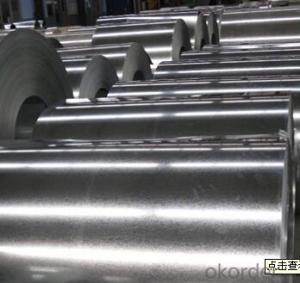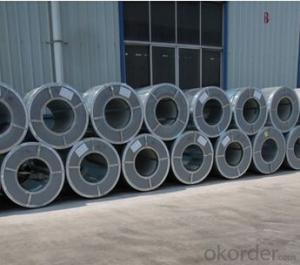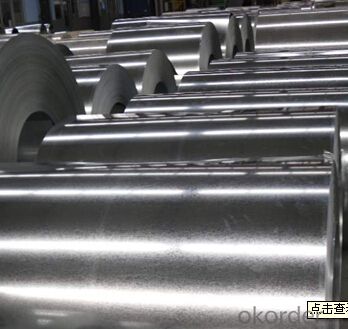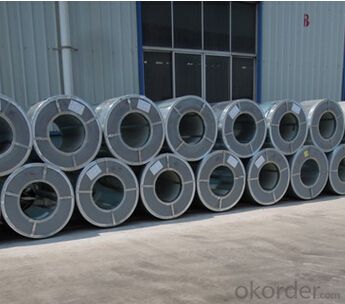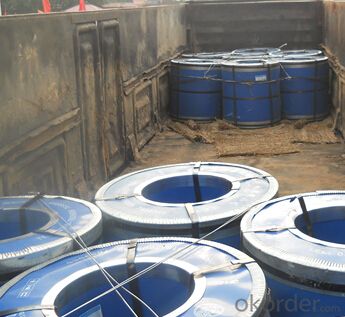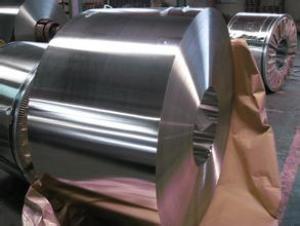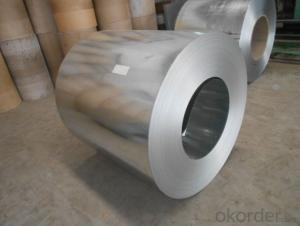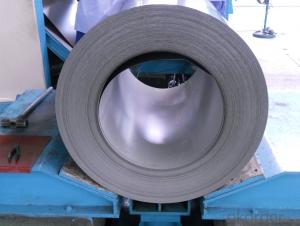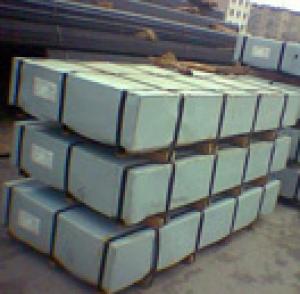Hot-Dip Galvanized Steel Sheets in Coils EN
- Loading Port:
- Tianjin
- Payment Terms:
- TT OR LC
- Min Order Qty:
- 25 m.t.
- Supply Capability:
- 50000 m.t./month
OKorder Service Pledge
OKorder Financial Service
You Might Also Like
1.Structure of Hot-Dip Galvanized Steel Sheet in Coils EN Description:
Hot-dip galvanized steel coils are available with a pure zinc coating through the hot-dip galvanizing process. It offers the economy, strength and formability of steel combined with the corrosion resistance of zinc. The hot-dip process is the process by which steel gets coated in layers of zinc to protect against rust. It is especially useful for countless outdoor and industrial applications. Production of cold formed corrugated sheets and profiles for roofing, cladding, decking, tiles, sandwich walls, rainwater protective systems, air conditioning duct as well as electrical appliances and engineering.
2.Main Features of the Hot-Dip Galvanized Steel Sheet in Coils EN:
• Excellent process capability
• Smooth and flat surface
• Workability, durability
• Excellent anticorrosive property
• High strength
• Good formability
• Good visual effect
3.Hot-Dip Galvanized Steel Sheet in Coils EN Images

4.Hot-Dip Galvanized Steel Sheet in Coils EN Specification
Standard: EN
Grade: DX51D+Z,S220GD+Z~S550GD+Z
Thickness: 0.12mm~5mm
Width: max 2000mm
Coil weight:3-12 MT
Coil ID:508/610mm
Surface structure: zero spangle, regular spangle or minimum spangle
Surface treatment: Chromate treatment, Oiled/dry, skinpassed/non-skinpassed
Packing: Standard seaworthy export package
Technology test results:
Processability | Yield strength | Tensile strength | Elongation % | 180°cold-bending |
Common PV | - | 270-500 | - | d=0,intact,no zinc removal |
Mechanical interlocking JY | - | 270-500 | - | d=0,intact,no zinc removal |
Structure JG | >=240 | >=370 | >=18 | d=0,intact,no zinc removal |
Deep drawn SC | - | 270-380 | >=30 | d=0,intact,no zinc removal |
EDDQ SC | - | 270-380 | >=30 | d=0,intact,no zinc removal |
5.FAQ of Hot-Dip Galvanized Steel Sheet in Coils EN
We have organized several common questions for our clients,may help you sincerely:
1.How about your company?
A world class manufacturer & supplier of castings forging in carbon steel and alloy steel,is one of the large-scale professional investment casting production bases in China,consisting of both casting foundry forging and machining factory. Annually more than 8000 tons Precision casting and forging parts are exported to markets in Europe,America and Japan. OEM casting and forging service available according to customer’s requirements.
2.How to guarantee the quality of the products?
We have established the international advanced quality management system,every link from raw material to final product we have strict quality test;We resolutely put an end to unqualified products flowing into the market. At the same time, we will provide necessary follow-up service assurance.
3. How long can we receive the product after purchase?
Usually within thirty working days after receiving buyer’s advance payment or LC. We will arrange the factory manufacturing as soon as possible. The cargo readiness usually takes 15-30 days, but the shipment will depend on the vessel situation.
- Q: I work the Copper plating line at a custom plating facility in MI.I like to use jumper cables with the jumper cable clamps to help confirm electric current is getting to my parts that I am plating. The acids in the Acid copper is constantly eating the steel and copper clamps. WIll I get a good enough current through stainless steel clamps? I use stainless steel hooks, but our maintenance man thinks that is one of the reasons why I have prblems with my parts turning out. I still think it has to do with the clamps getting eatin up. My question is Is stainless steel as good or reliable enough to run an electrical current to my parts if I am using stainless steel or is it best to use another method to try and get a better connection.Please state your sources or experience with working with electricity. I need to get honest answers and not this is my opinion. We are talking about my making a living so this is important to me so I can bring food home to my table. Thanks for all the help.
- Stainless steel is not such a good conductor as copper and the only metal with better conductivity is silver. Additionally, stainless steel will corrode in certain very corrosive environments without the presence of oxygen - i.e. when immersed in salt water. If you're getting problems caused by corrosion of the copper contacts you use there may well be a trade off so my advice is to do a trial and see what works best. You can check the conductivity of metals by simple online search for the period table:
- Q: How are galvanized steel coils different from regular steel coils?
- Galvanized steel coils differ from regular steel coils in terms of their protective coating. Galvanized steel coils are coated with a layer of zinc, which provides a protective barrier against corrosion and rust. This process, known as galvanization, involves dipping the steel coils into a bath of molten zinc or applying zinc onto the surface through various methods. Regular steel coils, on the other hand, do not have this protective coating, making them more susceptible to corrosion and rust. The zinc layer on galvanized steel coils not only acts as a physical barrier but also provides sacrificial protection, meaning that if the coating gets scratched or damaged, the zinc sacrifices itself to protect the underlying steel from corrosion. This makes galvanized steel coils highly durable and suitable for applications that require resistance to harsh environmental conditions, such as outdoor construction projects, automotive manufacturing, and the production of household appliances.
- Q: Can steel coils be coated with zinc-aluminum alloy?
- Yes, steel coils can be coated with zinc-aluminum alloy, which is often referred to as galvalume or zincalume coating. This type of coating provides excellent corrosion resistance and durability to the steel coils, making them suitable for various applications in industries like construction, automotive, and appliances.
- Q: What are the challenges in coil blanking for high-strength steel?
- Coil blanking for high-strength steel poses several challenges due to the unique properties of this material. One of the main challenges is the high tensile strength of the steel, which makes it more difficult to cut and blank compared to conventional steel grades. The high-strength steel is typically harder and less malleable, leading to increased tool wear and higher cutting forces. This requires the use of specialized cutting tools that are capable of withstanding these extreme conditions. Additionally, the increased cutting forces can lead to more vibration, which may affect the accuracy and quality of the blanks. Another challenge is the spring-back effect that high-strength steel exhibits after cutting. This means that the material tends to revert to its original shape, making it difficult to achieve precise dimensions and tolerances in the blanks. This issue requires careful consideration and adjustment of the cutting parameters to minimize the spring-back effect. Moreover, high-strength steel often has a higher carbon content, which can result in increased work hardening during the blanking process. Work hardening causes the material to become even harder and more brittle, making it more prone to cracks and fractures. To overcome this challenge, proper lubrication and cooling techniques are crucial to reduce heat buildup and minimize the risk of cracking. Furthermore, the increased strength of the steel may also affect the overall production efficiency. The higher cutting forces and tool wear mean that the cutting speeds may need to be reduced, leading to longer processing times. This can impact the productivity and throughput of the coil blanking process, requiring careful optimization and planning. In summary, the challenges in coil blanking for high-strength steel include increased cutting forces, tool wear, spring-back effect, work hardening, and reduced production efficiency. Overcoming these challenges requires specialized cutting tools, precise cutting parameters, proper lubrication and cooling techniques, and careful optimization of the production process.
- Q: What is the minimum diameter of a steel coil?
- The minimum diameter of a steel coil can vary depending on the specific manufacturing process and desired application. However, in general, the minimum diameter of a steel coil is determined by factors such as the thickness of the steel and the capabilities of the equipment used in the manufacturing process.
- Q: How are steel coils used in the manufacturing of safety systems?
- Steel coils are commonly used in the manufacturing of safety systems as they provide strength, durability, and stability to various components. These coils are often transformed into springs, which are crucial for absorbing and distributing impact forces during accidents or sudden movements. Springs made from steel coils are utilized in seatbelt retractors, airbag systems, suspension systems, and other safety mechanisms to enhance overall safety and protect occupants in vehicles and various industrial applications.
- Q: What is the role of steel coils in the production of fencing materials?
- Steel coils play a crucial role in the production of fencing materials as they are used to create the wire mesh that forms the main structure of the fence. The coils are unraveled and fed into a machine which cuts and shapes the steel into the desired size and form. This wire mesh is then further processed and treated to enhance its strength and durability before being incorporated into the final fencing products.
- Q: How are steel coils used in the production of furniture components?
- Steel coils are commonly used in the production of furniture components as they provide a strong and durable material for construction. These coils can be shaped, cut, and formed into various components such as frames, supports, and brackets, adding strength and stability to the furniture. Additionally, steel coils can be coated or painted to enhance their appearance and protect against corrosion, making them versatile and long-lasting materials for furniture manufacturing.
- Q: So we all know a 1000lb steel ball will sink in water, but if you were to leave the center of the ball hollow and fill with air, if the steel ball was big enough in diameter it should float correct? What size would the steel ball need to be to float?
- Say The radius of steel ball is R. Its shell is t thick so the air filled cavity if of radius r where r = R - t Steel has a density p The mass of the ball m is given m = 4/3 pi (R^3 - r^3) p If the ball is just to float then the mass dived by the must equal the density fo water d d = m / 43/ pi R^3 Equating m in the above equations yields (r/R)^3 = (p - d)/p or r = c R where c =((p-d)/p))^1/3 Using above leads to m = 4/3 pi R^3 (1 - c^3) p and hence R can be solved for So taking p (density of steel) 490 lb/ft^3 and d (density of water) at 62 lb/ft^3 yields c= 0.9557 Applying the equation above gives R = 1.565 ft or a diameter of 37.55 in The shell thickness is R (1 - c) or 0.06938 ft or 0.8327 in Note I do all my work in metric units so I had to do some conversions on the run. I hope you will check things to make sure the maths is correct. Anyway good luck
- Q: 1943 steel pennies
- if you collect coins, you need to learn that they must never be cleaned. cleaning, while it might make them look pretty, ruins their value as a collectable. ask your coin dealer.
Send your message to us
Hot-Dip Galvanized Steel Sheets in Coils EN
- Loading Port:
- Tianjin
- Payment Terms:
- TT OR LC
- Min Order Qty:
- 25 m.t.
- Supply Capability:
- 50000 m.t./month
OKorder Service Pledge
OKorder Financial Service
Similar products
Hot products
Hot Searches
Related keywords
